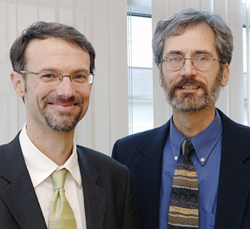University joins tech consortium
CIMIT membership will speed technology transfer

Boston University took another major step toward speeding the transfer of biomedical research from the lab to the patient bedside this week when it joined the Center for Integration of Medicine and Innovative Technology (CIMIT), a Cambridge-based consortium of hospitals, universities, and engineering laboratories.
Since its founding in 1998, CIMIT has focused on bringing together clinicians, scientists, and engineers for translational research, bringing new technologies along the innovation pipeline to the point where they can be used by clinicians to improve patient care.
“There have been several initiatives here at Boston University to embed a translational theme into research,” says Kenneth Lutchen, a College of Engineering professor and biomedical engineering department chairman. He cited specifically the recent five-year, $2.9 million grant from the Wallace H. Coulter Foundation to foster translational research in biomedical engineering. “It’s a cultural thing going on at BU, and the mission of CIMIT is entirely consistent with these initiatives.”
Every year, CIMIT provides between $2 million and $3 million in grants, ranging from $25,000 and $250,000 each, for research into using new technology to solve complex medical challenges. The application deadline for the next round of grants is March 1.
Lutchen emphasizes that the benefits of belonging to CIMIT go beyond the additional funding. “CIMIT is committed to helping research teams with potential market assessments, networking with industries, finding sources of next-phase funding, advice on protecting intellectual property,” he says. “These are important aspects of technology transfer that faculty don’t necessarily have the time or the expertise to manage for themselves.”
CIMIT membership will also expand opportunities for research collaborations outside of BU. Other consortium members include Massachusetts General Hospital, Brigham and Women’s Hospital, the Massachusetts Institute of Technology, Draper Laboratory, Partners Health Care, Beth Israel Deaconess Medical Center, and Boston Children’s Hospital. Current CIMIT-sponsored research projects include work on computer simulations for medical training, systems for remotely monitoring patients with heart disease, and noninvasive means of detecting cancer.
“We become part of this larger family of people interested in translational research, and we have more opportunities to work together with clinicians and engineers at a variety of institutions here in Boston,” says Mark Grinstaff, an ENG associate biomedical engineering professor and College of Arts and Sciences associate chemistry professor.
Grinstaff and George O’Connor, a School of Medicine professor and asthma researcher at the Pulmonary Center, were appointed last month as University “site miners,” scientific matchmakers between ENG researchers and clinicians at the Medical Campus. They will act as liaisons between the University and CIMIT and will serve on the consortium’s grant application review board with site miners from other member institutions and external reviewers.
“Our job is to let the BU faculty know about CIMIT and its funding and collaborative opportunities,” says O’Connor. “Serving on the panel that reviews the CIMIT grant proposals will help us provide even more insight and guidance to BU faculty as to what kinds of applications are most likely to succeed.”
Most CIMIT member institutions are primarily focused on either engineering or patient care, but BU has strength in both through the College of Engineering and the Medical Campus. This combination adds a unique dimension to CIMIT, according to its director, John Parrish.
“This partnership offers remarkable potential for exploring the unique needs of patients in an urban, community-based environment,” Parrish says of BU’s membership. “We look forward to collaborating with BU’s outstanding department of biomedical engineering, [and] Boston Medical Center leadership in trauma care will expand the range of opportunities for CIMIT-funded research.”